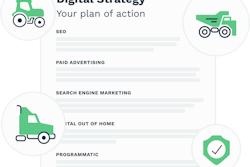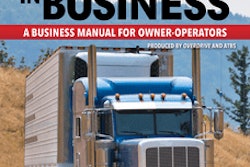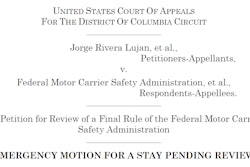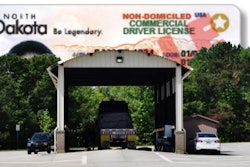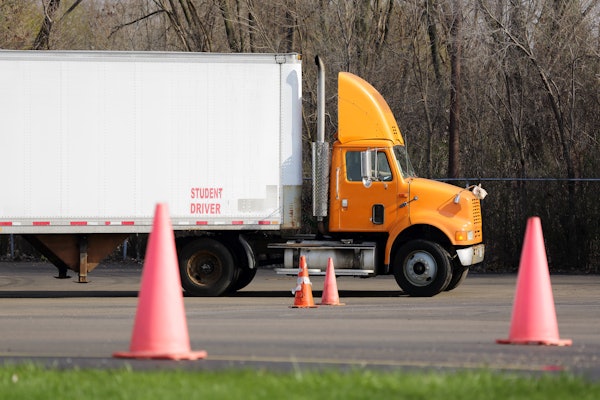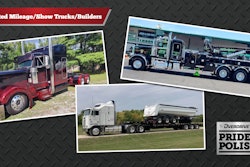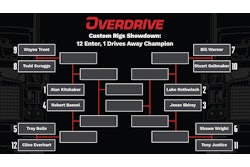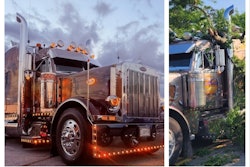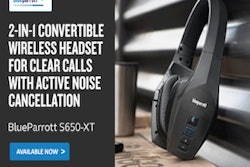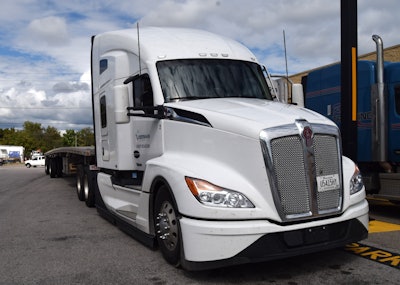
Updated November 3, 2025, to correct an error around the TruckerCloud platform's relationship to Northland Insurance -- the insurance company works with the platform to engage with insured telematics data.
A partnership between Daimler Truck Financial Services and Geico is the latest to offer fleets and owner-operators something of a usage-based insurance (UBI) model in a bid to use access to carrier data with potential to change the game on how premiums get underwritten.
Just last week, Daimler Financial announced what it called "Connected Insurance," a "data-driven insurance program," the company said, in which late model Detroit-powered Freightliner and Western Star owners "can voluntarily share their real-time Detroit Connect telematics data and take advantage of the benefits," including potentially reduced premiums of up to 10% depending on drivers' performance. That's "without the need to install additional on-board diagnostics or dashcam hardware in the truck."
The program is available to small fleets and owner-operators alike through Daimler Financial's subsidiary truck insurance agency in addition to physical damage, non-trucking liability and gap coverages Daimler has offered for years. In partnership with Geico's DriveEasy Pro program, assuming full commercial auto liability premiums are part of the Daimler offering, one-truck carrier availability might represent something of an evolution from where most insurers sat relative to usage-based programs three years ago, the last time Overdrive surveyed the UBI landscape. (Story continues after the snap poll below.)
More and more, said Fleet Safety Services compliance consultant Jeff Davis, insurers are willing and able to base some aspect of their underwriting not just on old "gold standards" like a driver's Motor Vehicle Record, a fleet's truck count, "loss runs" and basic geography of domicile and operation. Davis, speaking during an insurance-focused session at the National Association of Small Trucking Companies' conference in Nashville, Tennessee, October 24, emphasized the importance for small fleets of managing telematics data, and the savings that might come along with it, as a result.
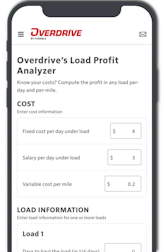
[Related: Usage-based insurance: Trucking's best-kept secret?]
The good news, according to Davis: small fleets "are in the sweet spot for managing telematics." He works with larger fleets, too, well above 100 power units, many of whom just "aren't good at it."
When he says managing telematics, what he means is actively engaging with data captured by your electronic logging devices, dashcams or some combination of devices to log so-called "critical events" like speeding, too-close following distance, hard braking/cornering -- and to use them in some way for safety management. A lot of that is going to come down to a small fleet owner-operator's coaching efforts with drivers. Or with themselves with awareness of their own tendencies, as the case may be.
Davis gave an example of a post-accident analysis of telematics data from a particular driver's truck at one of the larger fleets he works with. The accident in some measure was the fault of the truck's driver. In the aftermath, it was clear to Davis and the fleet's safety managers that the driver in question had "telegraphed the accident" with telematics-captured events in the long run of time leading up to it. Telematics-captured events, that is, neither the fleet nor operator had any real engagement with prior.
With telematics data analysis conducted on an ongoing basis -- and involving the driver in the effort, in particular -- "drivers will show you what their tendencies are," Davis added, presenting opportunity to actively improve.
[Related: Trucking's State of Surveillance: Inside the costs, benefits -- special report]
Simple fact of data engagement might help with more insurers than you think
When you're in the market for insurance or engaging your agent at time for renewal, and the agent asks what you're doing to improve safety, "Here's what I do," Davis gave as a hypothetical example, speaking as an owner to an agent. "We look at critical events with our telematics, and our speeding has come down this far, and our hard braking this far."
The ability to show engagement, he wagers, is going to be more and more important as usage-based policies become industry standard. The concept is a tough one for Davis to accept in some ways, given his long history in trucking and a professional nature of being "very, very, very old-school," he said. "I fought against GPS, ELDs, cameras. I didn’t like them." Yet he began to see the benefit at least for small fleets long ago in his efforts to help so many improve their rankings in the CSA Safety Measurement System, which themselves now hold plenty import for carriers' trucking insurance premiums.
Now, telematics data too are moving more directly, and dynamically, into the insurance market.
Mike Jordan, principal agent with NASTC Insurance Services, noted a handful of insurers the association's agency works with that offer programs for discounts with telematics data sharing. "If you have nothing to hide from that perspective, you can garner a competitive rate," he said, likening good data to "having the right tool for the job" of reducing premiums.
Mitigation of impacts from what Jordan called a "shock loss," a big accident that might otherwise result in a big premium increase at renewal, is another potential positive for a small fleet. He gave the example of an insured owner involved in a huge crash. He faced the prospect of moving "to a different insurance company" as a result, with premiums rising to an annual $20K-$23K "for just a one-truck guy. It's not something he could pay for."
Settle on that and the owner is effectively out of business as a carrier with authority, Jordan added.
Yet a review of telematics data showing generally safe behavior, a minimum of critical events, even with the shock loss on the record, Jordan noted, got a quote down to at least manageable, though still high: $16K and some change. "It was enough for him to stay in business," Jordan noted. Fundamentally, he added, "If you have good driver data, you can get good insurance rates."
[Related: Telematics beyond ELD systems: Promise, redundancy, real expense/uptime benefits]
Data engagement in practice
Overdrive's Small Fleet Champ in the 3-10-truck division this year, Wes Oberman of Oberman Logistics, noted the utility he's seen thus far with his own engagement with telematics data, using Motive's critical-event monitoring system. With the individual ELDs in Oberman-leased owner-operators' trucks capturing events like "speeding, hard braking, hard cornering, unsafe acceleration" among others, he said, "I can go into Motive and click on 'safety.' It shows me if anyone's" ELD has logged such an event.
It's not 100% foolproof. "I go in there and look at them," Oberman said. Sometimes, he well knows, a hard braking event is unavoidable, for instance. During the NASTC session with Davis and Jordan, Oberman brought up another instance where the Motive system had a 55-mph speed limit for a road going into Kentucky from Tennessee where the posted limit is actually 70 mph. The critical event in this case was from his own truck and driving. "It had me speeding in a 55-mph zone," he said, "and I was able to go in there and edit the actual speed limit for that area."
He also utilizes the owner's dashboard to set parameters for "when you're going to get an alert," he said, say beyond a certain mph threshold above the posted speed limit, or g-forces for braking and cornering events. He's completely turned off the rolling-stop alerts for stop signs after a proliferation of such warnings told him the sensitivity there was just too high for real-world operation.
The best thing about the entire system, though, might be the data-engagement piece of it, not just for himself as fleet owner but for the owner-operators leased on. The system computes a dynamically updated score for each operator based on events/behavior, including for Oberman himself. "They can all see their score for themselves," he said, and "everybody else's score, too."
It's turned the whole process into something akin to a competitive game. "They can see my score," he added, and "they're competitive with it." One day not so long ago, an Omaha, Nebraska-based owner named Rob called Wes Oberman to deliver some news. "He beat my score, and called me to rub it in my face. I have that kind of rapport with our guys at this point. They can give me all the crap that they want to."
 Wes Oberman
Wes Oberman
He considered a limited few truly usage-based insurance programs at his last renewal, working this past August with Mike Jordan and the NASTC agency. "There are only two-three actual companies fully using that model," Oberman said, underscoring that movement in that area has continued slowly these last years. "Two of those companies didn't like our business model" being all-owner-operator, and "another came in really high."
Ultimately, safety engagement and a good record resulted in a per-truck premium increase no more than the general rate of inflation in the wider economy. Come next August and the next renewal, after Davis and Jordan's session, he'll take another look at fully usage-based models again, that's certain, and meantime keep up what he's doing. "I'm doing most all of that," he said of Davis's message on engagement with the data.
Daimler Truck Financial's new "Connected Insurance" offering in partnership with Geico isn't the only recent development around insurance and telematics data. Jordan pointed to Northland Insurance and its inital rollout of a partnership with TruckerCloud, promoting insurance discount potential with telematics data sharing. Initially, "Northland buddied up with four ELD companies," he said. Now, you can share data with the insurance company via a total 30, according to the TruckerCloud website.
Jeff Davis charged those in attendance to make it a goal, if they weren't like Oberman and doing it already, to at the very least "look at it," he said. The adverse "roadside inspection or crash -- look at the driver's critical events leading up to it," assuming a capable ELD platform is being utilized. "Go home, and you and your safety department go in and just analyze for a couple of weeks -- see if you can figure out exactly what’s happening" in the telematics data. He was willing to bet, particularly for the larger among small fleets in attendance, "you will find low-hanging fruit -- you’ll find drivers with tendencies that make you shiver.
"We’re looking for major tendencies that could produce a loss, or CSA violations." In future, "formalize that program. We have to learn to take this hard, crude, digital data and serve it on a silver platter and coach [the drivers]. Nobody wants it. But it came to us with the ELD package."
He saw a future for small fleet use of telematics data akin to the adoption of road-facing cameras, now very common. "Insurance understood" the utility of cameras "before we did," he said. "We didn't use" cameras before that understanding, but "now we do."
[Related: In-cab and out, camera options expand amid push-pull of privacy concern, regulatory attention]

